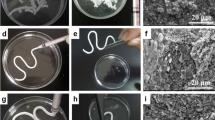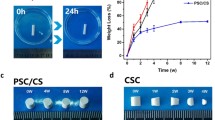Abstract
Polymethlylmethacrylate (PMMA) is the most frequently used cement for percutaneous vertebroplasty and kyphoplasty. To aid visualisation during surgery cements are doped with radiopacifying agents such as Barium sulphate (Ba2SO4) or Zirconium Dioxide (ZiO2). Mounting research suggests that these agents may impair the biocompatibility of the cements. However, incorporating an alternative radiopacifier agent with excellent biocompatibility would be a significant step forward. Bioactive radiopaque glasses incorporating elements such as strontium (Sr) and zinc (Zn), known to have beneficial and therapeutic effects on bone, are of great interest in this respect. In this study, the Ba2SO4 of the commercially available Spineplex® was incrementally replaced with a radiopaque therapeutic glass composition. The resulting effects on cement setting time, peak isotherm, ultimate compressive strength, Young’s modulus (up to 30 days cement maturation) and radiopacity were evaluated. The substitution lead to an increase in cement setting time from 13.1 mins for Spineplex® to 16.6–18.3 mins for the glass substituted cements. The peak exotherm during curing was reduced from 74°C for Spineplex® to a minimum of 51°C for the fully substituted cement, indicating that reduced thermal necrosis in the in vivo setting is likely with these materials. Ultimate compressive strength and Young’s modulus of each formulation showed no significant deterioration due to the substitution. Finally, the radiopacity of the substituted cements were reduced by up to a maximum of 18% in comparison to the control. However, the experimental formulations still maintained radiopacity equivalent to several millimetres of aluminium. As such the substituted cements had substantial equivalence to the Spineplex® control. In order to assess the clinical relevance of these findings further investigation is warranted.



Similar content being viewed by others
References
Weill A, Chiras J, Simon JM, Rose M, SolaMartinez T, Enkaoua E. Spinal metastases: indications for and results of percutaneous injection of acrylic surgical cement. Radiology. 1996;199:241–47.
Mathis JM, Barr JD, Belkoff SM, Barr MS, Jensen ME, Deramond H. Percutaneous vertebroplasty: a developing standard of care for vertebral compression fractures. Am J Neuroradiol. 2001;22:373–81.
Deramond H, Depriester C, Galibert P, Le Gars D. Percutaneous vertebroplasty with polymethylmethacrylate. Technique, indications, and results. Radiol Clin North Am. 1998;36:533–46.
Garfin SR, Reilley MA. Minimally invasive treatment of osteoporotic vertebral body compression fractures. Spine J. 2002;2:76–80.
Soin A, Kapural L, Mekhail N. Imaging for percutaneous vertebral augmentation. Tech Reg Anesth Pain Manag. 2007;11:90–94.
Carlier RY, Gordji H, Mompoint DM, Vernhet N, Feydy A, Vallee C. Osteoporotic vertebral collapse: percutaneous vertebroplasty and local kyphosis correction. Radiology. 2004;233:891–8.
Jasper LE, Deramond H, Mathis JM, Belkoff SM. Material properties of various cements for use with vertebroplasty. J Mater Sci: Mater Med. 2002;13:1–5.
Lewis G. Properties of acrylic bone cement: state of the art review. J Biomed Mater Res. 1997;38:155–82.
Breusch SJ, Kuhn KD. Bone cements based on polymethylmethacrylate. Orthopade. 2003;32:41–50.
Demian HW, McDermott K. Regulatory perspective on characterization and testing of orthopedic bone cements. Biomaterials. 1998;19:1607–18.
Wang JS, Diaz J, Sabokbar A, Athanasou N, Kjellson F, Tanner KE, et al. In vitro and in vivo biological responses to a novel radiopacifying agent for bone cement. J R Soc Interface. 2005;2:71–8.
Sabokbar A, Fujikawa Y, Murray DW, Athanasou NA. Radio-opaque agents in bone cement increase bone resorption. J Bone Joint Surg Br Vol. 1997;79B:129–34.
Bhambri SK, Gilbertson LN. Micromechanisms of fatiguecrack initiation and propagation in bone cements. J Biomed Mater Res. 1995;29:233–7.
Lewis G, Xu J, Madigan S, Towler MR. Influence of strontia on various properties of surgical Simplex P acrylic bone cement and experimental variants. Acta Biomater. 2007;3:970–9.
Hernández L, Fernández M, Collía F, Gurruchaga M, Goñi I. Preparation of acrylic bone cements for vertebroplasty with bismuth salicylate as radiopaque agent. Biomaterials. 2006;27:100–7.
Bohner M, Lemaitre J. Can bioactivity be tested in vitro with SBF solution? Biomaterials. 2009;30:2175–9.
Hench LL. Genetic design of bioactive glass. Amsterdam: Elsevier Sci Ltd; 2009.
Shah PMM, Sidhu SK, Chong BS, Ford TRP. Radiopacity of resin-modified glass ionomer liners and bases. J Prosthet Dent. 1997;77:239–42.
Dabsie F, Gregoire G, Sixou M, Sharrock P. Does strontium play a role in the cariostatic activity of glass ionomer? Strontium diffusion and antibacterial activity. J Dent. 2009;37:554–9.
Glass-ionomer fluoride release to adjacent caries Dental Abstracts 2009; 54: 149.
Erbe EM, Clineff TD, Gualtieri G. Comparison of a new bisphenol-a-glycidyl dimethacrylate-based cortical bone void filler with polymethyl methacrylate. Eur Spine J. 2001;10:S147–52.
Boyd D, Carroll G, Towler MR, Freeman C, Farthing P, Brook IM. Preliminary investigation of novel bone graft substitutes based on strontium-calcium-zinc-silicate glasses. J Mater Sci: Mater Med. 2009;20:413–20.
Murphy S, Boyd D, Moane S, Bennett M. J Mater Sci: Mater Med 2009; in press.
Jenni BJL, Popp R, Goldstein AS. JEffect of soluble zinc on differentiation of osteoprogenitor cells. Biomed Mater Res A. 2007;81A:766–9.
Chen D, Waite L, Pierce W. In vitro effects of zinc on markers of bone formation. Biol Trace Elem Res. 1999;68:225–34.
Boyd D, Li H, DA T, Towler M, Wall J. The antibacterial effects of zinc ion migration from zinc-based glass polyalkenoate cements. J Mater Sci: Mater Med. 2006;17:489–94.
Zhu L-L, Zaidi S, Peng Y. Induction of a program of gene expression during osteoblast differentiation with strontium ranelate. Biochem Biophys Res Commun. 2007;355:307–11.
Bonnelye E, Chabadel A, Saltel F, Jurdic P. Dual effect of strontium ranelate: stimulation of osteoblast differentiation and inhibition of osteoclast formation and resorption in vitro. Bone. 2008;42:129–38.
International Standard 5833:2002. Implants for surgery acrylic resin cements. Geneve, Switzerland: International Organization for Standardization.
Chavali R, Resijek R, Knight SK, Choi IS. Extending polymerization time of polymethylmethacrylate cement in percutaneous vertebroplasty with ice bath cooling. Am J Neuroradiol. 2003;24:545–46.
Lewis G. Injectable bone cements for use in vertebroplasty and kyphoplasty: state of the art review. J Biomed Mater Res B Appl Biomater. 2006;76B:456–468.
Deramond H, Wright NT, Belkoff SM. Temperature elevation caused by bone cement polymerization during vertebroplasty. Bone. 1999;25:17S–21.
Kovacic J, Lieberman IH, Togawa D, Bauer TW, Brodke D, Reinhart MK. The behavior of polymethylmethacrylate during kyphoplasty and vertebroplasty in the primate spine—a gross and histologic analysis. Spine J. 2003;3:79.
Heini PF, Berlemann U. Bone substitutes in vertebroplasty. Eur Spine J. 2001;10:S205–13.
Lim TH, Brebach GT, Renner SM, Kim WJ, Kim JG, Lee RE, Andersson G. B. J, An HS. Biomechanical evaluation of an injectable calcium phosphate cement for vertebroplasty; 2002.
Heini PF, Berlemann U, Kaufmann M, Lippuner K, Fankhauser C, van Landuyt P. Augmentation of mechanical properties in osteoporotic vertebral bones--a biomechanical investigation of vertebroplasty efficacy with different bone cements. Eur Spine J. 2001;10:164–71.
Belkoff SM, Mathis JM, Jasper LE, Deramond H. The biomechanics of vertebroplasty. The effect of cement volume on mechanical behavior. Spine. 2001;26:1537–41.
Molloy S, Mathis JM, Belkoff SM. The effect of vertebral body percentage fill on mechanical behaviour during percutaneous vertebroplasty. Spine. 2003;28:1549–4.
Belkoff SM, Mathis JM, Erbe EM, Fenton DC. Biomechanical evaluation of a new bone cement for use in vertebroplasty. Spine. 2000;25:1061–64.
Higgins KB, Harten RD, Langrana NA, Reiter MF. Biomechanical effects of unipedicular vertebroplasty on intact vertebrae. Spine. 2003;28:1540–7.
Author information
Authors and Affiliations
Corresponding author
Rights and permissions
About this article
Cite this article
O’Brien, D., Boyd, D., Madigan, S. et al. Evaluation of a novel radiopacifiying agent on the physical properties of surgical spineplex® . J Mater Sci: Mater Med 21, 53–58 (2010). https://doi.org/10.1007/s10856-009-3844-8
Received:
Accepted:
Published:
Issue Date:
DOI: https://doi.org/10.1007/s10856-009-3844-8




